






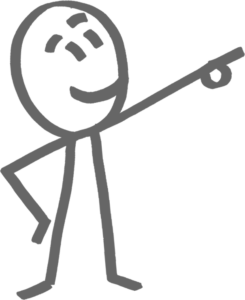
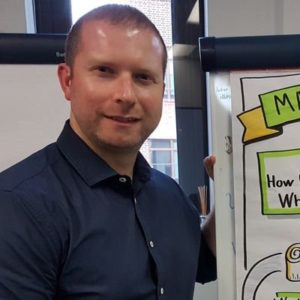
Agile Coach & Graphic Recorder
TLDR; Visual Friends Question & Answer – Use mindfulness and deliberate practice to uplift your visual capability.
The Visual Friends training team have been flat-out running bikablo® visual training over the last year. A segment of the training I really enjoy, is opening the question & answer space on the second day. We simply hang up a poster with a big Question Mark and ask for Post-Its to fill the space. As trainers, we want to create a 2-way conversation over the topics and I enjoy sharing my experience as well as collecting insights from the room.
It’s time to share back and expand on some of the insights that resonated with me and the groups I have trained through a blog series. Let’s add to the co-created body of knowledge on visual facilitation and bikablo®.
![]() “How do I get better? How often should you practice to become good, how do you get faster at drawing?”
“How do I get better? How often should you practice to become good, how do you get faster at drawing?”
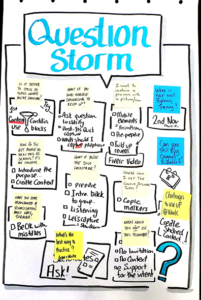
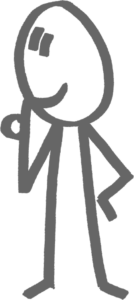
How can I improve?
Mindfulness & Deliberate Practice 1. I have moved towards a mindset change in how I practice drawing and visualisation. The mindset of “Practice Makes Permanent” resonates for me. In today’s world, perfect generally gets in the way of a faster, simpler outcome that still achieves the result. So following that mindset, here are the steps in a structured approach to being deliberate with practice which has helped me achieve goals.
Sir Richard Branson said “If somebody offers you an amazing opportunity but you are not sure you can do it, say yes – then learn how to do it later!”. Be open to learning and exploring new challenges. Changing your mindset about learning and practicing, will allow you to say YES more often and grow from those experiences.
Before starting a big visual project, I have often felt like I have ‘bitten off more than I could chew’. Sometimes I have felt challenged to the point of fear because the project required skills I simply didn’t have at that time. Some examples; “draw 6 communication posters in a weekend!”, “can you graphic record tomorrow at the conference?”, “let’s create a 5 minute sketch video on a complex strategy!”.
Initially, I had no idea on how to move forward. That feeling of fear, while true in your current context, is not helpful to achieving a goal.
I recently learnt about a framework to describe how we think and feel about situations – ‘above or below the line’. Being mindful of your emotional state in this situation is important. Reflect on what your body and mind are saying, what is true?, what may be an illusion?
There is a catchy acronym that I use in this situation, F.E.A.R; False Evidence Appearing Real. Identify that are those things that are really not true, but are physically influencing the way you see and feel in a situation. Once you have that understanding, move onto the next step, moving above the line towards a constructive mindset.
Think about breaking down your problem. What small step could you take, what bet could you take to get a different perspective or new information on the problem. Sit down with a pencil and paper in a quiet space and sketch out our idea. That will change your context to a place from where you can see the next step towards achieving your goal.
Ask someone for feedback, but hold the feedback lightly. See how that new perspective may also help guide you towards achieving the goal. Another reflection technique is to keep a journal. Share your visual on the Visual Friends LinkedIn group or on the Graphic Facilitation Facebook group.
By being focused and committed to improvement, you may surprise yourself with the outcomes you create. You focus on the differences that make a difference. Set a goal, keep your goal, practice often.
Challenge: People speak fast, there are 150 slides of content, I can’t keep up and I loose track of the narrative.
Goal: Improve active listening skills – improve content capture and organisation of information. Strengthen your response speed between listening, synthesizing and drawing. Capture less but focus on verb & noun combinations. Practice recognising the key themes and patterns coming through.
Challenge: I can’t remember the symbols when I draw and I can’t remember people!
Goal: Build Visual Dictionary – recall more symbols and shapes that improves the anchoring and aesthetic of your poster. The less you need to think about what to draw, the more you can focus on capturing the content of the dialogue – the most important part of visualisation.
How to focus when practicing? When you are at the wall, turn off mobile phone, take everything out of your hands and pockets, slow down, take a deep breath, remember lines are your friend, draw slow but deliberate. Really, really focus on the speaker. The outcome is you will get “into flow” faster and you can be 100% present to serve the group.
Creating opportunities in the workplace. Practicing visual facilitation in your place of work is ideal. Many different sources of content, different communication contexts. Offer to perform a visual recording of a team meeting, strategy session, all hands meeting or communication poster. Be humble and thankful of feedback. My steer here is to be strategic with what you say Yes to..
Go small Sketchnotes are possibly the best way to practice – in meetings, at presentations, visualise the conversation and share it.
Please get in touch, I’d like to hear your feedback on this article and your experiences in personal growth and working visually. hello@visualfriends.com. Stay tuned for the next instalment of Visual Q&A from Visual Friends.
ref 1: https://expertenough.com/2327/deliberate-practice-steps
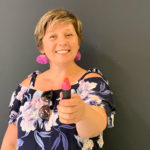
The article was written by Natalia Tsygankova. Natalia has always loved words and talking to people. She has put that passion to good use and has been sharing people’s stories in the community radio, TV and print media for the last 10 years. Natalia is also a big fan of true storytelling events and regularly volunteers at the most famous one – The Moth, interviewing the winner. You can hear her own story of moving to Australia from Russia in 1999 here. Natalia believes that everyone has a story – So what’s yours? Contact her today to share your story.
